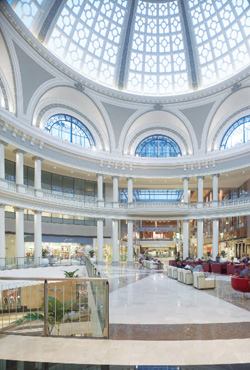RETAIL GETS A FLUORESCENT UPGRADE Mervyns is a family fashions and home goods neighborhood department store headquartered in the San Francisco Bay Area. With 189 stores in 10 states in the south and southwest and each store averaging 80,000 square feet, Mervyns is working to reduce electricity consumption, achieve pollution prevention, and minimize the environmental footprint of each facility.
The ultimate objective of this lighting retrofit was twofold: to enhance the shopping experience for Mervyns’ customers by improving both the quantity and quality of the in-store lighting, while also reducing the total electrical load, thus minimizing operating costs and improving financial performance. Teaming up with Sylvania Lighting Services (SLS), a division of Osram Sylvania that develops energy management programs for lighting systems, Mervyns hoped to achieve the aforementioned goals in 164 of its store locations.
To begin, the SLS team reviewed the existing lighting system and made recommendations for a new system that would meet the company’s objectives. High-performance, long-life Sylvania FO32/XPS Octron lamps and Sylvania Quicktronic High Efficiency QHE electronic ballasts were chosen and installed by SLS. This standardized the lamp types throughout all of Mervyns’ facilities. The previous light output and distribution was maintained by cleaning the existing fixtures to restore their reflectivity as well as installing new reflectors and louvers. Additional energy savings resulted by delamping the existing four-lamp fixtures from four to two and installing new lighting control sensors provided by WattStopper.
To calculate the company’s monetary gains through the system upgrade, multiple factors played a role. First was energy savings, along with maintenance costs, utility rebates, and tax reimbursements. Mervyns’ initial investment into the lighting upgrade was $11.5 million. With a projected system savings of $6 million per year, the company is expecting a pay-back within two years. The projected energy savings alone equals $4.3 million per year, the equivalent of more than 28,995,471 kWh saved annually in electricity consumption. With the new system, the lamp and ballast adjustments will save an average of $1.7 million in maintenance costs each year. The utility rebates and the Energy Policy Act of 2005 tax benefit will save an additional estimated $3.1 million. Add all of these considerations together and Mervyns’ initial investment in the lighting system pays for itself in less than one year.
FORD MOTOR CO.’S HIGH VELOCITY CENTER Ford Motor Co. was in the market to improve the efficiency of the overhead lighting system in its High Velocity Center (HVC), a 227,000-square-foot facility in Windsor Locks, Connecticut. Ford solicited energy services company New England Energy Management (NEEM) to assess how the lighting system could be improved to capitalize on energy savings. NEEM proposed replacing 650 high-intensity discharge (HID) lighting fixtures consisting of 400W and 1000W metal halide and pulse-start metal halide lamps with energy-efficient linear fluorescent lighting from GE Consumer & Industrial. Motion sensor control was proposed to reduce light output and energy usage by 50 percent at times of inactivity in the warehouse aisles.
To assist in the design of the new system, NEEM partnered with Henderson, North Carolina–based Optimum Lighting to develop a fixture utilizing GE’s latest program-start fluorescent lamps and ballasts. Each fixture was outfitted with six F32T8/XL/HL linear fluorescent lamps and UltraStart electronic ballasts from GE. The ballast was a key component, as it needed to have the high efficiency, energy savings, and performance benefits of an instant-start ballast, but it also had to protect the lamp life since the fixtures could be switched to low or off five or more times each day by the occupancy sensors.
NEEM designed Ford’s new fluorescent system and submitted it to Connecticut Light & Power’s (CL&P) rebate program. A 75 percent incentive was awarded to Ford by CL&P based on the high benefit-to-cost ratio the new system would achieve over time. The HID to fluorescent retrofit exceeded the project’s expectations, achieving a total payback in just seven months utilizing CL&P’s incentive rebate. It is estimated that the Windsor Locks lighting systems’ overhaul will top $78,000 per year.
The Windsor Locks HVC results are impressive, and subsequently Ford commissioned NEEM to ret-rofit 17 additional centers utilizing the same energy-saving system using the GE lamp and ballast combination in conjunction with occupancy sensors. NEEM will replace almost 12,000 HID fixtures with 96,000 linear fluorescent lamps and UltraStart electronic ballasts throughout the 17 facilities. The total energy savings are expected to exceed more than 20 million kWh each year.
LIGHTING SYSTEMS PAYBACK In each of these case studies, a total lighting system was either retrofitted or installed. The cooperation of all components—lamps, ballasts, fixtures, control system, and motion sensors—is required to run the system most effectively. The impressive savings these companies achieved through lighting upgrades paid back the initial investments in less than a year and, in some cases, only a few months.
Few corporations are aware of the rebates and incentives available for such retrofits, in addition to the energy savings. As the cost of electricity and energy continues to climb, the hope is that more companies will recognize lighting upgrades as a way to reduce their environmental footprint.
Jen Bickford received her MFA in lighting design from Parsons the New School for Design. She works in the New York City office of Tillett Lighting Design.
